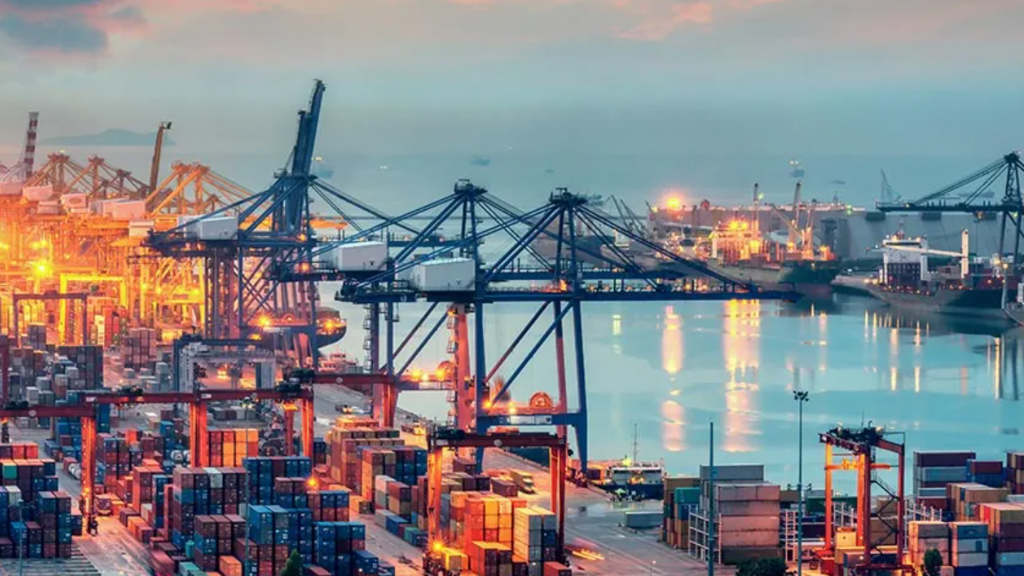The Russian President, Vladimir Putin, has been taking part in the Plenary session of the 10th Eastern Economic Forum. Putin gave a lengthy speech, which exclusively dealt with development issues in the Russian Far East, and covered regional economic, industrial development, rare earths, energy, logistics, the Trans-Arctic Corridor, shipbuilding, legal and tax incentives, an Arctic Free Trade Area, regional digitization, and the development of the Russian Far East as a new tech hub.
An initial introduction was conducted by Maria Rybakova. Our comments are listed as RPA.
Rybakova: “Dear Mr. President, I should say straight away: I am not an economist. I am a news presenter with a legal education who lives in Moscow. In short, I am oriented towards the humanities. But I also go shopping quite often, and I am someone who pays attention to prices, which, frankly, sometimes surprise me. I really know very little about economics, and you know, sometimes when you are looking for answers, you go on a video platform – which, as you know, now runs a bit slowly in Russia – and there, economists tell you that everything is bad: inflation is rising and the budget has been stretched to the limit. Then you go on another platform, and there, other economists tell you that everything is fine, everything is great, that there are breakthroughs ahead, we will beat everyone, and so on. Like any other Russian citizen, I have a question: Mr Putin, which of these economists should we trust?”
Putin: “Don’t take anyone at their word. The truth is, you should proceed from your own experience, rather than seeking the opinions of those who like to voice their views online. Instead, I suggest you consult the opinions of experts if you truly want to get to the essence of the issue that concerns you. I am not saying anything revolutionary here.
Even among specialists, views differ. The questions you have raised only appear simple on the surface. Take prices, for example. Rising prices are, essentially, inflation. The Central Bank is working to curb this inflation and bring it back to the well-known and necessary target of no more than 4–5 percent. But this requires keeping the key rate high, which raises concerns for those engaged in real production. Many people here will no doubt say: “This is unacceptable, it is impossible, the key rate must be sharply reduced.” But if that happens, prices will only rise further.
So, the only thing I can say is this: I want to assure you that Russia’s financial authorities – the Government of the Russian Federation and the Central Bank – are acting professionally. We have always, and I want to stress this, always proceeded from the principle that a stable macroeconomic policy is the foundation for developing the Russian economy and, consequently, the social sphere. We have pursued this course for many years, at least a decade and a half, and it has consistently delivered positive results, creating the conditions for the country to move forward. I am confident this will be the case again.”
Rybakova: “The main point I wanted to make is this: today I would like us to talk about the economy not in abstract, highbrow terms, not about institutional economics, but about the economy that matters to ordinary people in Vladivostok, to a typical family. That is the kind of economy that concerns me, and people like me.
I will now give the floor to the President.”
Putin: “Thank you. Allow me first to address the Russian part of our audience. I would ask you to extend a warm welcome to all our international guests. For my part, I wish to express my gratitude to our foreign colleagues for coming here, showing an interest in working with us, and devoting their valuable time to this forum.
Russia and Vladivostok once again are hosting participants and guests of the Eastern Economic Forum, with representatives from more than seventy countries around the world.
This year, the forum is being held for the tenth time. Let me remind you that the very idea of establishing it coincided with the launch of a new stage in the development of the Russian Far East. This major undertaking is aimed at creating broad opportunities for citizens, for young people, above all for businesses, to fully unlock the resource, industrial and logistical potential of this strategically important region of Russia, and to improve the quality of life for its residents.
Today’s tenth anniversary forum is not only an opportunity to take stock of the joint efforts of government bodies, entrepreneurs and public organisations, but also to outline the next steps – our long-term plans for the Far East. These plans concern strengthening its role both in Russia’s national economy and in international relations, above all in the rapidly growing Asia-Pacific region.”
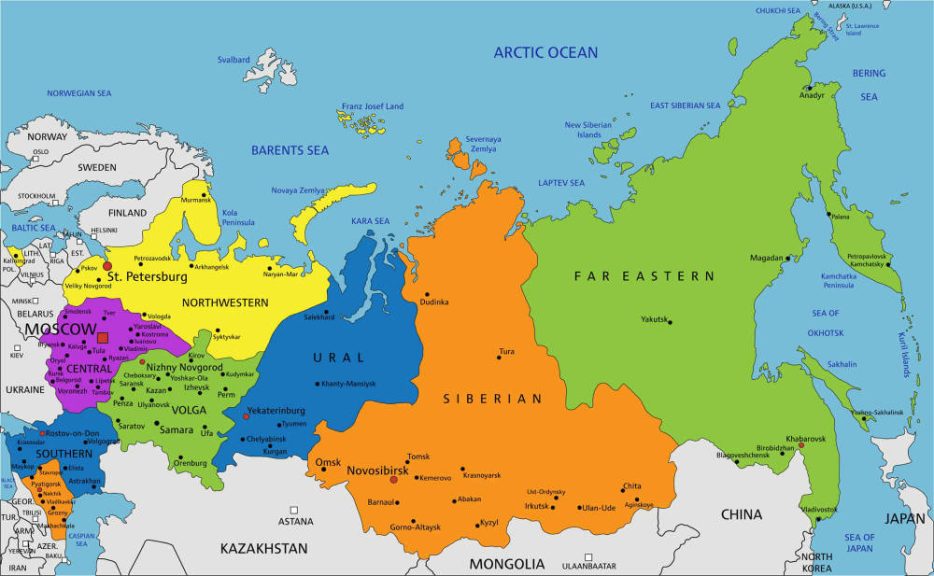
Russia Far East Development: Background
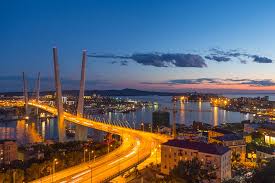
“As you know, the development of the Far East and Siberia has been designated as Russia’s national priority for the entire 21st century. This was announced in the Address to the Federal Assembly in 2013.
Subsequently, the legal framework was formed and updated, and a whole range of instruments to support business was introduced, including advanced special economic zones, the Free Port of Vladivostok, preferential arrangements for the Kuril Islands, and the establishment of a special administrative district on Russky Island.
Ambitious plans have been rolled out to strengthen transport, energy and utilities infrastructure. Decisions have been made to support housing construction, renovation, and the development of social facilities: schools, kindergartens, clinics and hospitals, and sports complexes.
All these measures are united within the large-scale State Programme for the Development of the Far East. It sets ambitious targets for accelerated economic and technological growth and for improving the wellbeing of the population across the Far Eastern regions of the Russian Federation.”
Russian Far East: Economic Indicators
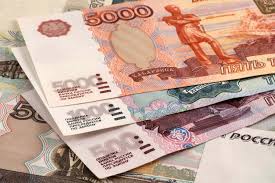
“These efforts are delivering results. In recent years, the Far East has taken a leading position across many key indicators – first and foremost economic ones – outpacing Russia’s overall growth rates.
Over the past 10 years, the GDP of the Russian Far East has increased more than 2.5 times, from ₽4 trillion to ₽11 trillion (US$49 billion to US$135 billion).
During this time, ₽20 trillion (US$245.5 billion) were invested in the fixed capital of Far Eastern companies and enterprises. A quarter of this amount was channelled into projects with state support in such sectors as mining, oil and gas chemistry, construction and others.
The leading regions in terms of fixed capital investment over these 10 years were as follows: Yakutia, with ₽4.5 trillion, the Amur Region, with ₽4 trillion, and the Sakhalin region, with ₽2.6 trillion. Together, these three account for 55% of all investment in the Far Eastern Federal District.
The investment dynamics in the Far Eastern regions are such that, in real terms, their volume last year was double that of 10 years ago. For comparison, across Russia as a whole the figure was 1.5 times higher. That, too, is a good result. But still, the Far East has done better. Per capita, investment in the Far East today is twice as high as the national average.”
RPA: To provide some context to these figures, the current GDP of the Russia’s Far East is roughly equivalent to that of Uzbekistan. Russia’s capital investment into the Russian Far East is equivalent to 3.5 times France’s annual spend on its military and defence budget.
Russian Far East: Industrial Development

Putin: “What does this mean? It means that not only is a modern industrial base being formed, but in fact a new industrial map of the region is emerging. Thousands of new growth points have already appeared, including world-class enterprises such as the Baimsky Mining and Processing Plant in Chukotka, the Udokan Copper project in the Trans-Baikal Territory, the Amur Gas Processing Plant, the Nakhodka Mineral Fertiliser plant, the Zvezda Shipbuilding complex in Primorye, the Khabarovsk Hydrometallurgical plant, and many others.
The growth of business and entrepreneurial activity, along with the expansion of economic opportunities in the Far East, forms the foundation for the region’s future development. It is important to maintain steady progress in its traditional sectors, in areas that are already on an upward trajectory, to develop infrastructure and logistics links, to ensure reliable supplies of affordable and clean energy, and, of course, resources.
I should also note that the Far East’s resource base and mineral extraction are expanding. Over the past decade, coal and gold production in the region has grown almost 1.7 times. This has been made possible in part by the declarative principle of subsoil licensing, which has enabled greater private capital involvement in geological exploration, significantly increasing the number of newly discovered deposits, including major ones such as the Lugokan Gold and Copper Deposit in the Trans-Baikal Territory and the Roman Gold and Silver deposits in Yakutia.”
RPA: Russia holds Gold Reserves of about 2,329.63 tonnes, and has unmined reserves of an estimated 12,000 tonnes, the largest in the world.
Rare Earths

“On the issue of rare earth metals, which are used in high-tech industries, instrument-making, nuclear technology, electronics and other spheres, these resources are often accumulated in dumps during the development of deposits, including here in the Far East. There is a system for registering these resources. They can be extracted and effectively used with the development of new technologies.
At the same time, we should regularly review these valuable components throughout the production chain, including at the stage of their reprocessing and export in the form of concentrates. In addition, we must introduce advanced technologies for enriching and processing rare and rare earth metal ores. We must also encourage demand for them at new industrial facilities in Russia.
In February this year, we agreed to approve a long-term plan for the development of the rare earth metals industry. I would like the Government to present this no later than November this year.”
RPA: Russia has the world’s fifth largest rare earth reserves, and is planning to increase its share of global rare earths production to 10% of the total by 2030.
Energy

“A meeting on the development of the energy complex of the Far East was held prior to this plenary session. It is clear that the demand for electricity in the region will increase with the development of the economy and the social sphere. Consequently, we must plan the construction of energy facilities so that they meet the growing demands of businesses, cities and villages, and the people. The focus is on the expansion of gas and modern coal generation, as well as using the huge potential of hydropower generation.
The hydroelectric power plants on rivers in the Far East are a low-impact electricity source, and new ones must be built. Their construction implies modern engineering and technological solutions, and our leading company in this field, RusHydro, has the necessary experience and groundwork. However, it is obvious that the development of hydropower generation calls for major investments.
Relevant instructions have been issued. I hope that the Government and our colleagues in the regions will continue to give special attention to the development of small and large hydroelectric power plants. I would like to emphasise that we are not only talking about the economic aspect. Responsible water use, maintenance of perennial runoff, and flood prevention are integral parts of the development of hydropower generation that have a direct impact on the environment, agriculture and the safety of cities and towns.”
RPA: Although when it comes to energy and Russia the majority of people think of oil and gas, hydroelectricity generation also shows huge potential. Russia’s freshwater resources are concentrated in its thousands of rivers and lakes, including Lake Baikal, which itself holds 20% of the world’s unfrozen freshwater. The Russian Far East is ripe for hydro-electric production due to its topographic nature, while other countries require development expertise in this sector, such as Laos and Nepal meaning there is technical expertise export potential in addition to regional energy development.
Logistics
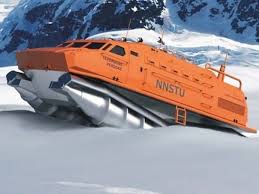
“Rivers in the Far East are also natural transport arteries connecting territories and ensuring deliveries to cities and towns within the framework of the northern supply.
In this context, a separate issue is logistics. In recent years, the load on the transport system of the Far East has grown significantly. The region’s ties with foreign countries are being strengthened. All of this requires the upgrading of road and rail arteries, the expansion of seaports and the creation of modern transport hubs with automated warehouses and digital cargo processing.
We will continue modernising the Eastern railway network – the BAM and the Trans-Siberian Railway. By 2032, their carrying capacity should be one and a half times higher than at the beginning of this year.
It will also be necessary to further expand the railway links to the seaports of the Far East, which are developing dynamically, primarily through private investment. Over the past 10 years, port capacity in the region has effectively doubled. Today, it stands at almost 380 million tonnes of cargo per year.
According to the current federal project, the Far Eastern ports’ capacity should increase by a further 115 million tonnes of cargo per year by 2030.
In the Far East, transport bridges to China have already been built: the Nizhne-Leninskoye-Tongjiang and Blagoveshchensk-Heihe bridges. Plans also include the construction of new bridges, including one to North Korea across the Tumannaya River, which is scheduled to open next year. It is essential to actively develop transport and logistics hubs in the vicinity of these bridges to make full use of their capacity. In addition, border crossings are being modernised. This task has also been set, as it is of considerable importance: a single transport artery is not enough, and appropriate administrative logistics are required.
I would also add that airports in every region of the Far East are being upgraded. They now handle more than 14 million passengers a year, including tourists, who are increasingly visiting these remarkable and beautiful places.
In this context, I would like to note the initiative of VEB.RF. Master plans have been prepared for the development of twelve new all-season resorts in Primorye, Sakhalin and Kamchatka. This will allow the number of tourists visiting these regions to almost double over the next ten years.
I would also highlight such landmark developments as the restoration of flights between Vladivostok and Pyongyang, as well as the launch of direct air services between the capitals of Russia and North Korea. The flight on this route took place at the end of July. A month earlier, direct train services between Moscow and Pyongyang were resumed. I am confident that these measures will contribute to the further rapprochement of our countries and the establishment of stronger ties.”
RPA: Russia’s Far Eastern Port total capacity target of handling 495 million tonnes of freight 2030 is comparable to over double that of Los Angles Port, the largest in the United States, with 222 million tonnes.
Trans Arctic Corridor
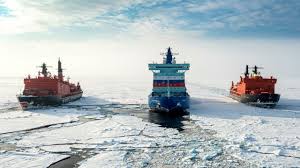
Of course, a particularly significant topic for the Far East, for our entire country, and for the whole Eurasian continent is the development of the Trans-Arctic Transport Corridor. It runs from St Petersburg through Murmansk, Arkhangelsk, and the Northern Sea Route, all the way to Vladivostok.
We see that interest in this route is growing, both from Russian companies operating in the Arctic and from foreign carriers. And this is not just about individual, one-off shipments, but about forming a stable cargo base. We will develop the Trans-Arctic Corridor.
We often speak about the Northern Sea Route. But if you have noticed, I specifically said – and continue to say – Trans-Arctic Corridor, because we have concluded that we need to operate on a larger scale, and that this artery must function as part of a complex system with all the territories adjoining the Northern Sea Route and their capacities.
This is a comprehensive system that should integrate maritime, rail and road transport. It will allow us to use the potential of our largest rivers, such as the Ob, Yenisei, and Lena. Everything must work as a single, unified system.
Our task is not only to establish reliable and safe sea routes in the Arctic and enable year-round operation of the Trans-Arctic Corridor. There is also work, as they say, onshore: developing communications and navigation, ship servicing systems, and emergency and rescue infrastructure. And, of course, this includes modernising seaports in the Arctic and the Far East.
Incidentally, just yesterday, the Artyom Multimodal Hub was opened in the Primorye Territory. It handles containers arriving both from abroad and from Russian regions, and it is expected to improve the efficiency of northern supply deliveries.
It is very important that similar modern transport and logistics centres develop in our country, that there are more and more of them, and that cargo delivery and handling become faster and more efficient. And I would like to emphasise that it is precisely at such points, in logistics hubs, that advanced technologies, including unmanned systems, should be applied.
The Trans-Arctic Corridor must primarily operate in the interests of the domestic economy and our regions of the Far East, Siberia, and the Arctic, taking into account cooperation between them and opening new opportunities for business.
Here, I would like to underline two potentially significant directions for development.”
Shipbuilding

“First, the creation of modern shipbuilding centres. They should be capable of producing the full range of vessels needed for the route, from tugs and supply ships to bulk carriers and ice-class gas carriers, as well as ultra-powerful icebreakers.
Second, to increase the efficiency and resilience of the Trans-Arctic Corridor, we need to provide direct access for cargo from Siberia and the Urals to Arctic maritime routes.
I ask my colleagues in the Government and the Russian Maritime Board to assess the feasibility of these proposals and provide their recommendations.
RPA:The Russian government has unveiled a massive, US$6 billion plan to build hundreds of new vessels by 2050, upgrade its shipbuilding capability, and increase the workforce in its maritime industry, much of this to be in passenger vessels and cargo ships.
Legal & Tax Motivation

Previously, advanced and innovative mechanisms, such as Priority Development Areas (PDAs), gave a strong boost to economic growth and private initiative in the Far East.
The law on PDAs was adopted in late 2014, and the mechanism was launched in 2015. The goal was to create truly globally competitive environment for doing business in the Russian Far East. Therefore, we developed PDA arrangements based on the best business and investment climate practices, including from the Asia-Pacific region.
What benefits does this mechanism provide today? These are, first of all, low insurance premium rates (7.6% for 10 years). The federal revenue tax will be zero for five years. The regional revenue tax will amount to anywhere from zero to 5% in the first five years, and 10% for the next five years.”
RPA: The standard corporate income tax rate in Russia is 25%.
Putin: “The subsidised tax rate on mineral extraction is provided. In addition, the PDAs provide for a free customs zone, as well as reimbursement of a portion of the expenses involved in building infrastructure and issuing low-interest loans to businesses.
The reason I am dwelling on the PDA terms in such great detail is because they are unique for business, and not only in our country, but in many other countries around the world.”
RPA: China in particular made significant economic progress by launching various Special Economic Zones, providing similar tax breaks as described, along with Free Trade zones, which improve business cashflow by deferring import duties and VAT payments, as well as promoting employment. Other benefits such as lower energy and utilities costs, larger government contributions to employee welfare costs, lower than market value rents and so helped develop China’s domestic industrial base to a point where many of what were once domestic companies have become MNC’s and are engaged in projects around the world. Russia is following this same path.
Putin: “PDAs have proven their effectiveness. They have helped launch numerous investment projects, systematically support entrepreneurs and companies at the most important stage during construction, setting up the production cycle, and reaching design capacity. In the Far East, 18 PDAs have been created employing over 300 residents, who have invested almost ₽4 trillion (US$49 billion) and created 95,000 new jobs. The Government has made several decisions to expand the boundaries of specific PDAs to accommodate new projects.”
Arctic Free Trade Area

“Based on existing experience, I propose taking a radical step and to launch a single preferential regime for business throughout entire Russian Far East and the Arctic. This must be in place by January 1, 2027.
The task is to simplify the use of support measures for entrepreneurs, companies and their new projects. In other words, investors should have access to incentives wherever they take their money, in every Far Eastern or Arctic region, city and town.
I would like to point out that the launch of the single preferential regime will preserve all the terms extended to investors in priority development areas. They do not have to worry that anything will be changed spontaneously. This also concerns the residents of international priority development areas. This instrument stipulates even longer-term profit tax privileges and the so-called grandfather clause – not everyone in the hall knows what it is, so I will explain this term. This clause precludes any changes in the terms of operation for up to 15 years and stipulates an individual approach and support for each investor, including foreign companies.
The legal framework is ready, and international priority development areas will start operating in the Transbaikal Territory, the Amur Region, the Jewish Autonomous Region, and the Khabarovsk and Primorye territories on January 1, 2026. We invite all interested partners to take advantage of this opportunity.
Regarding the single preferential regime for the Far East, I would like to say this: the list of incentives, their precise parameters, deadlines and industry focus will be determined by the Government together with our colleagues in the Far Eastern entities of the federation. But there are some fundamental issues I would like to point out.
Using the results achieved in the mining and processing industries and solid infrastructure, we must start a new development stage in the Far East, shaping an economy of the future, radically improving living conditions in cities and towns, training in-demand professionals and launching high-tech projects. This is the essence of the new stage. We must turn the entire territory of the Far East into a hub for high-tech projects. It is a vast territory with a sparse population and large areas where people can be employed. We must use modern methods for the development of this territory.
National projects to ensure the country’s technological leadership have already been launched. On the basis of each of these, I instruct the Government to prepare and approve an appropriate development programme for the Far East and the Arctic by the end of the year.
For a technological breakthrough, a genuinely bold approach to regulation and the legal framework for business operations is required. These must give the green light to innovation, stimulate the development of cutting-edge solutions, and facilitate their implementation in pilot and subsequently serial production, as well as in the social sphere and everyday life.
For instance, an experimental legal regime is already in effect on Sakhalin. It allows for the accelerated testing of unmanned technologies. I instruct the Government to create conditions for their widespread application on agricultural lands, in environmental protection and natural resource management, as well as at industrial and logistics sites. Why should unmanned technology not be developed in such areas? There are none of the risks that might arise in densely populated regions of the country. Moreover, life itself demands the use of such technologies. Take, for example, forest fires that break out hundreds of kilometres away from the centres responsible for responding to them. Unmanned technology is perfectly suited for use in these vast areas.
There are other opportunities for applying modern technologies across these vast territories. This is precisely where they should be deployed. However, this requires a corresponding workforce. What must be done to ensure such a workforce? Conditions must be created so that people can live here, so that they want to live here. Social infrastructure must be developed, cultural facilities must be enhanced, and so on. Otherwise, there will be no workforce, and consequently, there will be no people capable of advancing these technologies. This is a comprehensive task.
It is evident that such solutions will be in demand not only on Sakhalin but also in other regions of the Far East, including the Amur Region, the Trans-Baikal Territory, Chukotka, and so on.
In this regard, I consider it possible to extend the experimental legal regime for unmanned systems to all Far Eastern regions and expand it primarily to include such areas as the use of digital platforms, artificial intelligence, and data exchange.”
RPA: This is a massive undertaking and means that billions of dollars are to be spent on the Russian Far East in terms of available financial incentives and additional benefits to encourage people to relocate and invest in the region. Tax breaks lasting up to 15 years will comfortably allow for smaller businesses to develop, promote wealth creation, and ultimately lead to the development of significant Russian Far East Multinationals companies being created, many with significant expertise in cold weather climates. Wealth creation will be fastest in the Russian Far Eastern regions than in the traditional Western centres.
Russian Far East: Digitization

In June, at the St Petersburg Economic Forum, I spoke about the importance of leveraging the advantages of electronic marketplaces. Within the framework of the experimental legal regime, I propose utilising the infrastructure of domestic information platforms for state and municipal procurement in the field of education.
The Russian Far East must become an advanced digital development region, especially in data circulation. Of course, this circulation should take into account matters of confidentiality and security. We talk about this all the time. We will revisit this topic at the artificial intelligence forum, which will take place closer to the year end. I look forward to the Government preparing corresponding proposals.
The Russian Far East As A Tech Hub
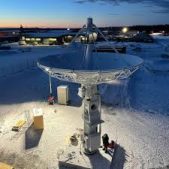
Next is to develop and master technologies and to establish modern production facilities, at least 100 industrial, business and technology parks with the proper areas and utilities will have become operational in Russia by 2030. At least ten such parks will need to be created in the Russian Far East and the Arctic regions. I am confident that their state-of-the-art infrastructure and capabilities will be popular with the start-up companies that are implementing promising projects and, among other things, planning to manufacture products that are designed to replace foreign analogues, including construction materials, and medical and transport equipment, to name a few.
In order to promote the development of domestic production facilities, conditions must be met for a wider use of the so-called offset contracts, when investments in new factories, workshops, or enterprises are guaranteed by state orders. It is likewise important to expand the practice of interregional offset contracts, under which production facilities open in one constituent entity of the Russian Federation, and products manufactured under guaranteed orders are shipped to more than one region.
Financing innovative ideas and technological projects is a separate issue. Private investors and venture investment have a greater role to play under these arrangements than the state. The Voskhod Fund, which has supported about 40 companies in robotics, medicine, and space technologies, is a compelling example to back up this point.
I am asking our colleagues from the Government to carefully review the experience of this Fund and to help scale up its activities to include our technological leadership projects. Please focus on this.
In general, I believe a transparent, modern, and effective financial ecosystem must be created in the Far East. The Eastern Exchange, which is, for all intents and purposes, a Far Eastern stock exchange, is operational. I suggest working out plans for further expanding it, including financial channels, regulatory framework, and incentives for placing corporate shares.”
RPA: Russia is also investing in specific cluster manufacturing parks in the Far East, with Putin suggesting more than 100 new parks are to be created. Again, these typically provide tax and other manufacturing incentives. Business clusters are parks where independent, yet related businesses can be next to each other to reduce costs. An example is in shoe-manufacturing (although Russia will be looking at higher-tech examples) where differing leather, plastic, rubber, metal, fabric and other component parts are all manufactured by different companies, yet sit together to enable a complete finishing product to be produced faster and more efficiently.
Summary
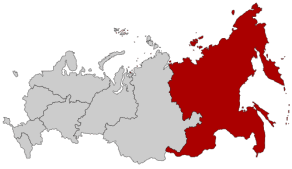
The Russian Far East is the easternmost part of Russia and the Asian continent, and is coextensive with the Far Eastern Federal District, which encompasses the area between Lake Baikal and the Pacific Ocean. The area’s largest city is Khabarovsk, followed by Vladivostok. The region shares land borders with the countries of Mongolia, China, and North Korea to its south, as well as maritime boundaries with Japan to its southeast, and with the United States along the Bering Strait to its northeast. It should not be confused with Siberia, which is to the West.
The Russian Far East accounts for 6,952,600 km2 or about 41% of Russia’s total landmass. To compare, Texas has a landmass of 695,662 km2, or about 10% of the Russian Far East. The European Union has a landmass of 4,233,255 km2.
The main development issue with the Russian Far East is the population, which amounts to about 7.5 million, or slightly over than 1 person per km2, one of the lowest population densities in the world. Resolving this will be a major challenge for Far Eastern development plans, although the current policy seems to be to attract people from other areas of Russia by providing fiscal incentives. This is likely to mean a migration away from the expensive Western part of Russia, and the cities of Moscow and St. Petersburg. With a Russian lower-middle class population of about 15 million, attracting these people to migrate to the Far East where there are perhaps better wealth creation opportunities will, over time, become an increasing demographic trend. Doing that has to coincide in the provision of social services, and construction of schools, hospitals and related infrastructure – issues Putin also discussed.
This may later need to be augmented with imported labour, such as from India, Pakistan or Africa, where ten year employment contracts may be provided in return for salaries in Russia at rates higher than generally available in their home regions. While no policy exists at this time to cater for such migrants, the substantial human capital needs of the Russian Far East almost certainly means that at some point, state policy will need to be introduced to inject human capital, as well as financial capital into this massive region to enable it to reach the potential that Putin outlined.
Note: Articles like this take many hours to prepare. Our analysis comes with decades of regional experience and professional expertise. When using our content, kindly refer to Russia’s Pivot To Asia as the source.
Enquiries? Email us at info@russiaspivottoasia.com
Further Reading



